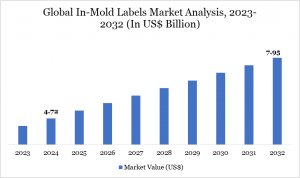In-Mold Labels Market to Reach $7.95B by 2031, Boosted by Sustainability and Smart Packaging Trends | DataMIntelligence
The In-Mold Labels market is set to grow at 6.73% CAGR, driven by smart packaging, sustainability, and demand from food, cosmetic, and personal care sectors.
The In-Mold Labels Market is experiencing steady growth, driven by the demand for efficient, durable, and sustainable labeling solutions. These labels are embedded within the surface of containers during molding, offering superior aesthetics, resistance to moisture and wear, and eliminating the need for adhesives. In 2023, the market reached a value of US$ 4.72 billion and is projected to climb to US$ 7.95 billion by 2031, expanding at a CAGR of 6.73% during the forecast period (2025-2032).
The packaging industry, especially for food and beverage, cosmetics, and personal care, continues to be the major end-user of IML technology.
Get Exclusive Sample Report : https://www.datamintelligence.com/download-sample/in-mold-labels-market
Market Drivers:
Surging demand for premium packaging: IML offers high-resolution graphics, enhancing shelf appeal for consumer goods.
Rising focus on sustainability: IML is 100% recyclable and integrates well with mono-material packaging, reducing environmental impact.
Increased automation in labeling processes: IML supports faster, cost-effective, and less labor-intensive operations.
Growth in the food and beverage sector: The hygiene and durability of IML make it ideal for dairy, frozen food, and ready-to-eat packaging.
Improved product security and branding: Tamper-evident and anti-counterfeit features support brand integrity.
Market Key Players are :
CCL Industries, Inc.
Constantia Flexibles Group GmbH
Coveris Holdings S.A.
Huhtamaki Group
Cenveo Inc.
Hammer Packaging
Fuji Seal International Inc.
Avery Dennison Corporation
Innovia Films Ltd.
Inland
Market Segmentation:
The In-Mold Labels market is segmented based on material type, printing technology, end-user industry, and region.
By material, polypropylene (PP) dominates due to its compatibility with most molding processes. Printing technologies such as offset, flexographic, and gravure are widely used.
In terms of end-use, the food and beverage segment holds the largest share, followed by cosmetics, pharmaceuticals, and automotive components.
Regionally, Europe leads the market owing to strong packaging regulations and high adoption, while Asia-Pacific is emerging as the fastest-growing region.
Latest News of USA:-
In 2024, Inland Manufacturing announced an investment in a new automated IML production line in Wisconsin, aimed at serving growing demand from dairy and home care brands. Meanwhile, Avery Dennison expanded its smart labeling division, integrating RFID technology into IML solutions to enhance inventory tracking and consumer engagement.
Latest News of Japan:-
In 2024, Fuji Seal International Introduced a new series of ultra-lightweight in-mold labels designed specifically for convenience food packaging, aiming to enhance recyclability and to reduce the plastic usage.
These labels are designed to improve recyclability and reduce plastic use. Huhtamaki also collaborated with a major Japanese FMCG firm to co-develop bio-based in-mold labels tailored for organic food packaging.
Key Developments are :
CCL Industries launched digital IML printing for rapid prototyping and customization.
Constantia Flexibles developed a peelable IML technology suited for resealable containers.
Coveris expanded its portfolio with in-mold barrier labels for extended shelf life in dairy products.
Innovia Films introduced transparent in-mold label films that support see-through packaging designs, enhancing product visibility and shelf appeal.
Cenveo introduced metallic-effect IMLs for premium cosmetic packaging.
Conclusion:
The In-Mold Labels market is undergoing significant transformation as demand grows for packaging that is eco-friendly, efficient, and visually impactful.
With continued investments in automation, material innovation, and smart labeling technologies, IML is well-positioned to redefine packaging solutions across industries. Companies leveraging eco-friendly practices and digital enhancements will lead the way in capturing new opportunities in this dynamic market.
Browse for more Reports :
Packaging Automation Solution Market
Bag-In-box Packaging Machine Market
Sai Kumar
DataM Intelligence 4market Research LLP
+1 877-441-4866
email us here
Visit us on social media:
LinkedIn
X
Legal Disclaimer:
EIN Presswire provides this news content "as is" without warranty of any kind. We do not accept any responsibility or liability for the accuracy, content, images, videos, licenses, completeness, legality, or reliability of the information contained in this article. If you have any complaints or copyright issues related to this article, kindly contact the author above.
Xin Weisheng and Nandani Medical Laboratories Collaborate to Advance Intelligent Pharma Quality in India
LNE Surveys Offers Professional BIM for Existing Commercial Properties Nationwide
New Insights from Beacon Media + Marketing Reveal Why Behavioral Health Clinics Need More Than Paid Ads to Thrive Online
Kalendarium
Więcej ważnych informacji
 Jedynka Newserii
Jedynka Newserii

 Jedynka Newserii
Jedynka Newserii

Prawo

Duże możliwości korzystania z funduszy europejskich przez polskie firmy. Szczególnie w obszarze obronności
W ramach polityki spójności i Krajowego Planu Odbudowy Polska ma do dyspozycji 190 mld zł na wsparcie polskich firm. Środków dla przedsiębiorców nie zabraknie również w nowej perspektywie finansowej po 2027 roku. Dedykowane im programy KPO obejmują nie tylko wsparcie finansowe, ale również inwestycje i reformy deregulujące polską gospodarkę. Ich celem jest zwiększenie jej konkurencyjności, jak również bezpieczeństwa w kontekście położenia geopolitycznego Polski. Na szczególnie szeroką ofertę programów mogą liczyć sektory obronności i transportowy.
Farmacja
Zniesienie zakazu reklamy aptek może zwiększyć świadomość pacjentów o usługach farmaceutycznych. Taki może być skutek wyroku TSUE

W czerwcu Trybunał Sprawiedliwości Unii Europejskiej uznał, że obowiązujący w Polsce całkowity zakaz reklamy aptek narusza prawo UE. To oznacza, że Polska będzie musiała dostosować regulacje. Dla pacjentów wyrok oznacza szerszy dostęp do informacji o usługach farmaceutycznych, a dla właścicieli aptek – możliwość legalnej komunikacji z rynkiem. Naczelna Rada Aptekarska obawia się chaosu prawnego i wezwała resort zdrowia do uregulowania sytuacji prawnej.
Prawo
Przemysł chemiczny czeka na szczegóły unijnego wsparcia dla sektora. Najważniejsza jest obniżka cen energii

Komisja Europejska przedstawiła plan działania dla modernizacji i wzmocnienia konkurencyjności unijnego przemysłu chemicznego. Plan ma być rozwiązaniem najważniejszych wyzwań stojących przed sektorem chemicznym w Europie, w tym m.in. wysokich cen energii i nieuczciwej konkurencji na rynkach zagranicznych. KE chce również promować inwestycje w innowacje, ESG, a także uprościć unijne przepisy dotyczące chemikaliów.
Partner serwisu
Szkolenia

Akademia Newserii
Akademia Newserii to projekt, w ramach którego najlepsi polscy dziennikarze biznesowi, giełdowi oraz lifestylowi, a także szkoleniowcy z wieloletnim doświadczeniem dzielą się swoją wiedzą nt. pracy z mediami.










.gif)

 |
| |
| |
|